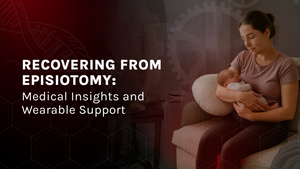Recovering From Episiotomy: Medical Insights and Wearable Support
An episiotomy—a surgical incision made in the perineum during childbirth—can significantly impact postpartum recovery. While this procedure may be necessary in certain deliveries, it often leads to discomfort, swelling, and challenges in mobility during the healing process. Incorporating seamless support garments into postpartum care can aid in alleviating these issues, promoting a smoother recovery.
Understanding Episiotomy Recovery
Post-episiotomy recovery involves managing pain, preventing infection, and supporting the healing of perineal tissues. Proper hygiene is crucial; using a peri bottle with warm water to cleanse the area and patting dry can help maintain cleanliness without irritating the stitches. Applying cold packs or "padsicles" (sanitary pads soaked in witch hazel and frozen) can reduce swelling and provide pain relief. Regular follow-up with healthcare providers ensures that the healing process is on track and addresses any complications promptly.
Clinical Guidelines for Episiotomy Recovery
According to Kettle and Tohill (2008), perineal care post-episiotomy is crucial for infection prevention, wound healing, and pain management. Some evidence-based recovery practices include:
-
Perineal hygiene: Gentle cleansing with warm water using a peri bottle after urination.
-
Cold therapy: Application of ice packs to reduce swelling and discomfort.
-
Pain management: Use of safe analgesics as prescribed.
-
Pelvic floor exercises: Starting gentle Kegel exercises as advised by healthcare professionals can aid circulation and healing.
Medical professionals also emphasize the importance of psychological support, especially when women are experiencing prolonged discomfort or trauma related to the delivery (East et al., 2012).
The Role of Wearable Support in Postpartum Care
A newer development in postpartum care is the use of wearable support garments to enhance recovery. These garments offer light compression and targeted support to the pelvic region and lower abdomen, which can significantly aid women during their healing process.
In a randomized controlled trial, Williams, Owen, and Gomes (2017) found that postpartum support garments improved women's comfort, mobility, and reduced perception of pain during the early weeks after delivery. Women who wore these garments reported greater ease in walking, sitting, and caring for their infants—all essential aspects of early motherhood.
Goh and Krause (2016) also noted that stabilizing the pelvic region through support can reduce complications such as postpartum hemorrhage and facilitate better uterine involution—making garments especially helpful after interventions like episiotomy.
Benefits of Seamless Support Garments
Seamless postpartum garments specifically designed for women recovering from episiotomy offer the following advantages:
-
Reduced Perineal Pressure: Targeted compression helps manage swelling without aggravating the incision.
-
Improved Mobility: Gentle support allows for better movement, which is critical for daily maternal tasks.
-
Discreet and Comfortable: Seamless construction ensures no chafing or visible lines under clothing.
-
Enhanced Healing Environment: Breathable materials help reduce irritation and moisture buildup.
Always consult your healthcare provider before using compression garments post-delivery, especially if you experienced severe tearing or complications.
Conclusion
Episiotomy recovery is a deeply personal journey, but it need not be endured without effective tools. Backed by clinical research and guided by evolving postpartum care standards, seamless support garments offer practical, non-invasive solutions for comfort, mobility, and confidence. When paired with proper medical guidance and perineal care, they can significantly improve the healing experience after an episiotomy.
References
- East, C. E., Lau, R., Biro, M. A., & Barnett, C. A. (2012). Midwives’ and doctors’ perceptions of episiotomy: A qualitative study. Birth, 39(4), 310–318. https://doi.org/10.1111/birt.12002
- Goh, J. T. W., & Krause, H. G. (2016). Primary postpartum haemorrhage. In S. Arulkumaran & M. Regan (Eds.), Best Practice & Research Clinical Obstetrics & Gynaecology, 30(1), 28–41. https://doi.org/10.1016/j.bpobgyn.2015.10.005
- Irion, O., & Boulvain, M. (2000). Episiotomy for vaginal birth. Cochrane Database of Systematic Reviews, (2). https://doi.org/10.1002/14651858.CD000081
- Kettle, C., & Tohill, S. (2008). Perineal care. Clinical Evidence, 2008, 1401. https://www.ncbi.nlm.nih.gov/pmc/articles/PMC2907625/
- Williams, K., Owen, L. J., & Gomes, M. (2017). The effect of support garments on postpartum recovery: A randomized controlled trial. Journal of Women's Health Physical Therapy, 41(3), 152–158. https://doi.org/10.1097/JWH.0000000000000092

